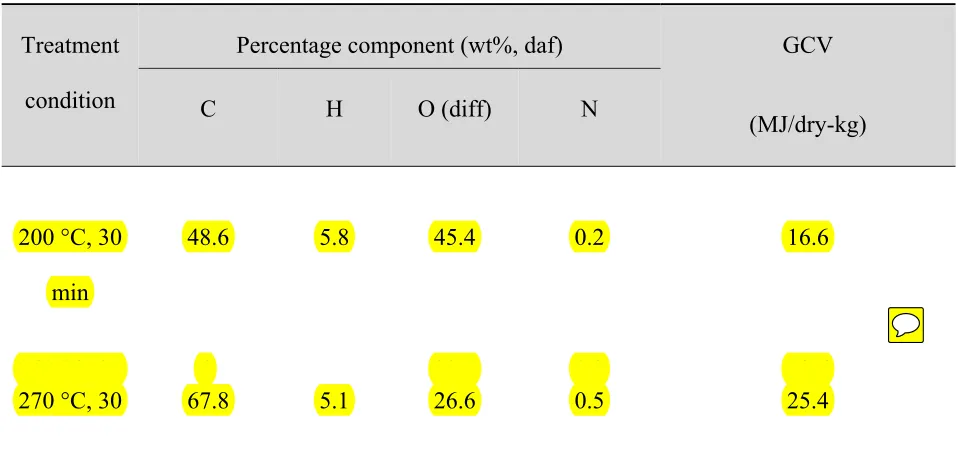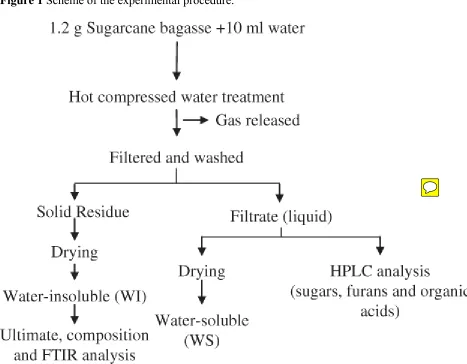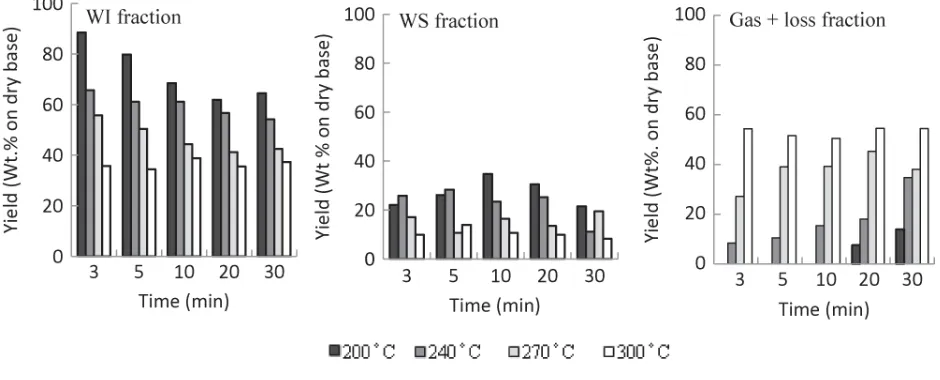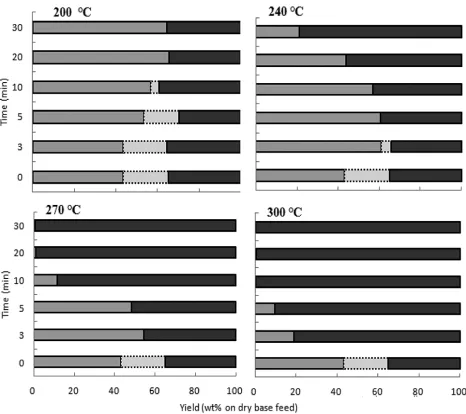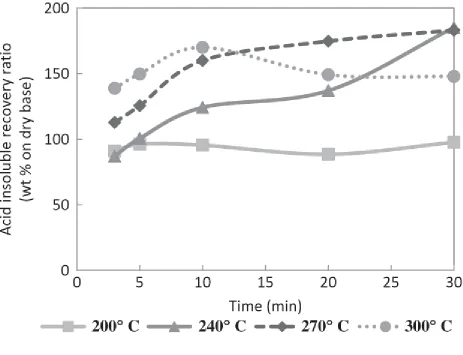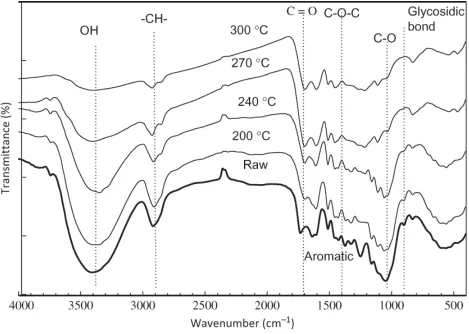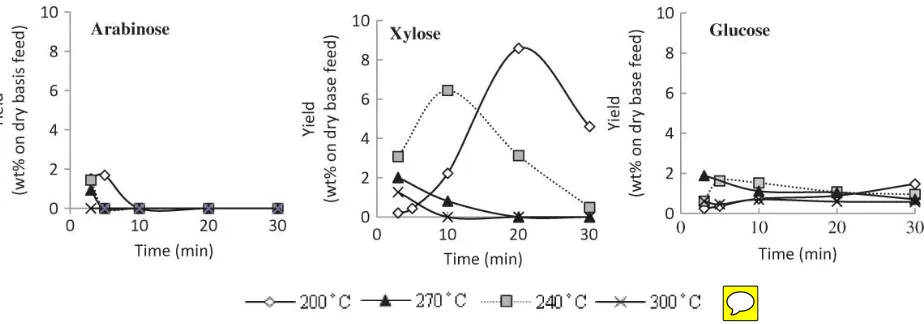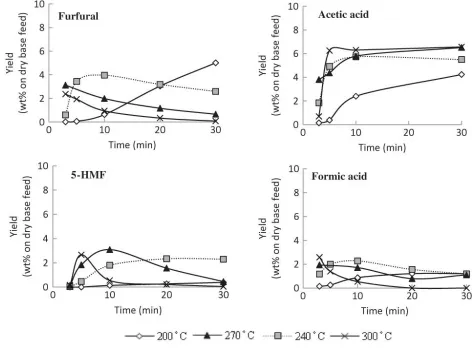I nform a Lt d Regist ered in England and Wales Regist ered Num ber: 1072954 Regist ered office: Mort im er House, 37- 41 Mort im er St reet , London W1T 3JH, UK
International Journal of Green Energy
Publicat ion det ails, including inst ruct ions f or aut hors and subscript ion inf ormat ion:
ht t p: / / www. t andf online. com/ loi/ lj ge20
Hot Compressed Water Treatment of Solid Waste
Material from the Sugar Industry for Valuable Chemical
Production
Dewi Agust ina Iryani ac , Sat oshi Kumagai b , Moriyasu Nonaka a , Yoshinobu Nagashima a ,
Keiko Sasaki a & Tsuyoshi Hiraj ima a
a
Depart ment of Eart h and Resources Engineering, Kyushu Universit y, Fukuoka, 819-0395, Japan
b
Research & Educat ion Cent er of Carbon Resources, Kyushu Universit y, Fukuoka, 819-0395, Japan
c
Depart ment of Chemical Engineering, Lampung Universit y, Indonesia Accept ed aut hor version post ed online: 27 Mar 2013.
To cite this article: Dewi Agust ina Iryani , Sat oshi Kumagai , Moriyasu Nonaka , Yoshinobu Nagashima , Keiko Sasaki & Tsuyoshi Hiraj ima (2013): Hot Compressed Wat er Treat ment of Solid Wast e Mat erial f rom t he Sugar Indust ry f or Valuable Chemical Product ion, Int ernat ional Journal of Green Energy, DOI: 10. 1080/ 15435075. 2013. 777909
To link to this article: ht t p: / / dx. doi. org/ 10. 1080/ 15435075. 2013. 777909
D iscla im e r : This is a version of an unedit ed m anuscript t hat has been accept ed for publicat ion. As a service t o aut hors and researchers w e are providing t his version of t he accept ed m anuscript ( AM) . Copyedit ing, t ypeset t ing, and review of t he result ing proof w ill be undert aken on t his m anuscript before final publicat ion of t he Version of Record ( VoR) . During product ion and pre- press, errors m ay be discovered w hich could affect t he cont ent , and all legal disclaim ers t hat apply t o t he j ournal relat e t o t his version also.
PLEASE SCROLL DOWN FOR ARTI CLE
Full t erm s and condit ions of use: ht t p: / / w w w.t andfonline.com / page/ t erm s- and- condit ions
This art icle m ay be used for research, t eaching, and privat e st udy purposes. Any subst ant ial or syst em at ic reproduct ion, redist ribut ion, reselling, loan, sub- licensing, syst em at ic supply, or dist ribut ion in any form t o anyone is expressly forbidden.
HOT COMPRESSED WATER TREATMENT OF SOLID
WASTE MATERIAL FROM THE SUGAR INDUSTRY FOR
VALUABLE CHEMICAL PRODUCTION
Dewi Agustina IRYANI1,3, Satoshi KUMAGAI2, Moriyasu NONAKA1, Yoshinobu NAGASHIMA1, Keiko SASAKI1 and Tsuyoshi HIRAJIMA1*
1
Department of Earth and Resources Engineering, and 2Research & Education Center of Carbon Resources, Kyushu University, Fukuoka 819-0395, Japan
3
Department of Chemical Engineering, Lampung University, Indonesia
*Corresponding author: hirajima@mine.kyushu-u.ac.jp
ABSTRACT
Sugarcane bagasse, the solid waste material produced in the sugar industry, was subjected to
treatment in hot compressed water. The experiments were performed in a batch-type reactor
containing slurry of 10 ml of water and 1.2 g of solids. The reactor was heated to temperatures
ranging between 200°C and 300°C for reaction times of 3 to 30 min. The product was separated
into liquid and solid fractions. Each fraction was analyzed to investigate the alteration of the
main lignocellulosic polymers by hot compressed water. Results for the liquid fractions showed
that increased temperatures and reaction times completely dissolved hemicellulose and cellulose
in the water, leaving lignin in the solid product. During treatment, hemicellulose and cellulose
gradually decomposed into simple sugars, which were then degraded and decomposed into
furfural, 5-(hydroxymethyl)furfural (5-HMF) and organic acids. However, the yield of furans
and some organic acids decreased and became undetectable at 300°C and with increasing
reaction time. The solid fraction was also characterized before and after treatment. Results
showed that the hydrogen and oxygen content of the solids decreased with increased reaction
conditions, due to dehydration and decarboxylation reactions. The reactions also increased the
carbon content of the treatment products by 1.2–1.6 times that in the raw material, suggesting
that the hot compressed water treatment of sugarcane bagasse can be considered for the
provision of valuable chemicals for biofuel and high-carbon-content material (biochar).
Keywords: Agricultural waste, sugarcane bagasse, hot compressed water, lignocellulosic
biomass, biofuel
INTRODUCTION
Today, many researches are focusing on ways of biomass utilization from agricultural waste as
an alternative source of raw material for chemical industries and biofuel production. The
utilization of biomass has many advantages compared with fossil fuel; biomass is carbon oxide
neutral, low content of sulfur, nitrogen and ash, sustainable and relative environmentally benign
source of green energy (Demirbas 2001; Balat 2008; Zhang 2010).
Among of biomass from agricultural waste, sugarcane bagasse is one of an abundant agricultural
waste with great potential for transformation into energy and chemical feedstock (Ju et al. 2010).
Generally, during the extraction process in sugar factories, about 280 kg or about 30% of wet
bagasse are produced from 1 ton of sugarcane (Rodrigues et al. 2003; Sun et al. 2004). Currently,
often 50% of the waste is used as a primary fuel source for sugar mills to generate heat and
power and to run the sugar milling process, while the remainder is stockpiled (Lavarack et al.
2002). The stockpiled bagasse is of low economic value and constitutes an environmental
problem for sugar mills and surrounding districts, especially if stockpiled for extended periods,
due to the risk of spontaneous combustion (Lavarack et al. 2002).
In order to utilize and increase the economic value of sugarcane bagasse, several conversion
methods have been proposed and carried out. The conversion methods are either
biochemical/biotechnology methods or thermo-chemical methods, such as pyrolysis
(Garcia-Pèrez et al. 2001; Tsai et al. 2006) and hydrothermal methods (Sasaki et al. 2003; Boussarsar et
al. 2009) of producing energy, pulp and paper, chemicals and fermentation-based products
(Pandey et al. 2000).
Recently, hydrothermal treatment has attracted more interest than other thermo-chemical
conversion processes. Comparing with other methods, the required temperature range of
hydrothermal treatment is lower than for gasification and pyrolysis (Zhang et al. 2010).
Hydrothermal treatment, particularly using hot compressed water, is suitable for material with
high moisture content (Inoue et al. 2002). Hot compressed water has unique properties of density,
dielectric constant, ion product, viscosity, diffusivity, electric conductance, and solvent ability.
Hot compressed water has an ion product (Kw) about three orders of magnitude higher than that
of ambient liquid water; in this condition, water acts as an acid-base catalyst precursor (Kruse
and Dinjus, 2007).
Furthermore, it enhances hydrolysis reactions and decomposes lignocellulosic polymer
into useful chemicals that are dissolved into the liquid product (Kumagai et al. 2004; Yan et al.
2009; Yin et al. 2011; Yuliansyah et al. 2010) and remained a solid product with high caloric
value (Hirajima et al. 2003; Yuliansyah et al. 2010; Inoue et al. 2002).
A search of the literature reveals only a few reports on the hydrothermal conversion of sugarcane
bagasse, especially using hot compressed water. Most of those were focused only on
pre-treatment of the material for fractionation of the three main lignocellulosic polymers (Allen et al.
1996; Sasaki et al. 2003), for bioethanol feedstock (Ju et al. 2010; Cardona et al. 2010) and for
sugar production (Laser et al. 2002). Allen et al. (1996) and Sasaki et al. (2003) determined the
decomposition temperature of sugarcane bagasse using a percolator-type reactor. From these
studies, they reported that hemicelluloses and lignin were mainly extracted as a water-soluble
fraction in the temperature range 200–230°C, while the cellulose fraction was either hydrolyzed
at higher temperatures in the range 230–280°C, or was recovered as solid residue. These
treatments were focused on decomposition of the main lignocellulosic polymers.
The decomposition reaction of cellulose and hemicellulose for production of other chemicals
such as furans and organic acids from sugarcane bagasse has not previously been investigated
and described in detail, probably because previous treatments were conducted at lower
temperatures and for fixed reaction times. Thus, in the present study, we explored the possibility
of producing valuable chemicals from sugarcane bagasse, particularly the decomposition
products of cellulose and hemicelluloses. The decomposition products from cellulose and
hemicelluloses such as glucose and furans compounds (such as furfural and 5-HMF) are
important chemicals for bioethanol and for alkane biooil production. Therefore, the hot
compressed water treatment was performed in order to understand the specific condition for
chemicals production. The treatment was conducted by varying the temperature and reaction
time in the ranges 200–300°C and 3–30 min. This study emphasized the effect of treatment
conditions on the composition and yield recovery of compounds in the liquid product, and the
characteristics of the solid products were also examined in order to understand the
decomposition mechanism occurring during the hot compressed water treatment.
MATERIALS AND METHODS
Raw material
Sugarcane bagasse provided by the sugar industry was ground using a cutting mill to form a
powder with maximum 1.0 mm particle size, which was dried in oven at 60°C before
commencing treatment. The composition of sugarcane bagasse was determined using procedure
recommended by US National Renewable Energy Laboratory (NREL) (Sluiter et al. 2005).
Prior to analyzing the composition of the raw material, a sample was extracted using ethyl
alcohol to determine wax content using a soxhlet extractor for 8 h at 80°C. Afterward, 0.15 g of
de-waxed sample was dried and treated using 1.5 ml of 72 wt% H2SO4 at 30°C for 1 hour.
Subsequently, 42 ml of water was added to the treated sample and hydrolyzed for 1 hour in an
autoclave at 121°C. The hydrolyzed sample was cooled, then filtered using a GP 16 glass filter
under vacuum conditions with washed several times using hot water. The residue was then dried
at 105°C overnight, and was noted as a Klason lignin (i.e. acid-insoluble lignin). At the same
time, the concentration of sugars such as xylose, arabinose and glucose, as well as other
chemicals in the filtrate, were analyzed by a high-performance liquid chromatography (HPLC).
The chromatograph was equipped with a KC-811 column (JASCO) and refractive index (RI)
detector (RI-2031, JASCO). The HPLC operated under the following conditions: oven
temperature 50°C, using 2 mM HClO4 as the mobile phase, delivered at a flow rate of 0.7 ml/min.
Therefore, cellulose and hemicellulose were determined with the correlations:
Cellulose (wt %) = glucose (wt %) × 0.9 (1)
Hemicellulose (wt %) = (xylose + arabinose) (wt %)×0.88 (2)
In addition, the ash content was determined by measuring the weight of residue before and after
heating of 1.0 g the sample at 575°C for 5 h. The analysis showed that the raw material
compositions were: cellulose 43.4 wt%, hemicellulose 21.7 wt%, lignin 20.3 wt%, wax 2.3 wt%,
and ash 5.6 wt% on a dry basis.
Method of treatment
The hydrothermal experiments were conducted in a batch-type reactor (SUS 316, 14 ml) and
equipped with K-thermocouple to measure temperature of reaction. A slurry consisting of 10 ml
water and 1.2 g sugarcane bagasse was placed in the reactor. A stream of N2 gas was used to
purge air in the reactor and to regulate initial internal pressure of 0.5 MPa. The reactor was
immersed into a preheated salt bath at the desired temperature and a given reaction time. The
reactor was then removed from the salt bath and the reaction was quickly quenched by
immersion of the reactor into a water bath to room temperature. The treated slurry was collected
and filtered with a GP 16 glass filter under vacuum to separate solid residue and liquid filtrate for
further analysis. The liquid product was analyzed by HPLC and the yield of each chemical was
determined as:
(3)
At the same time, 10 g of filtrate and solid residue were dried at 105°C until the weight was
constant, yielding water-soluble (WS) and water-insoluble (WI) fractions. The gas yield fraction
and the weight loss during filtration were calculated based on mass balance:
Yield of gas + weight loss = 100 – WS – WI (4)
The elemental composition of the WI fraction or solid product was measured using a Yanaco
CHN Corder MT-5 elemental analyzer. The elemental value was then used to calculated the
gross caloric value. The gross caloric value (GCV) was calculated according to Dulong‘s
equation:
GCV (MJ kg-1) = 0.3383C + 1.442 (H – O/8) (5)
Where C, H, and O are percentage of carbon, hydrogen, and oxygen, respectively. A Fourier
transform infrared (FTIR) spectrometer (JASCO 670 Plus) using the KBr disk technique was
applied to identify chemical structures and functional groups. In addition, cellulose,
hemicelluloses and lignin content in the solid product were also determined to assist in
interpreting the decomposition mechanism during the treatment. The scheme of experimental
procedure is shown in Figure 1.
Figure 1
RESULTS AND DISCUSSIONS
Distribution of products of hot compressed water treatment
Figure 2 shows the product distribution following treatment, represented as percentages of WI,
WS and gas + loss fractions for different temperatures and reaction times. (The loss fraction is
the small amount of unrecovered material following filtration and drying). As can be seen in
Figure 2, the WI fraction gradually decreased with increases in both temperature and time.
However, at elevated temperatures (e.g. 300°C) the WI fraction was observed to be
comparatively constant. In case of the WS fraction, at temperatures around 200°C and 240°C
(< 10 min) the yield of WS increased with increased of reaction time. This occurred only under
lower reaction conditions, however; at elevated conditions the WS yield decreased, as did the WI
fraction. In addition, increasing treatment temperatures caused a progressive increase in
decomposition into gas.
Gas formed when the organic compounds dissolved in the WS fraction decomposed during the
treatment. Low gas yield was observed at lower temperatures and shorter treatment times.
However, in contrast to the other fractions, gas yield increased with longer treatment times.
Finally, the decomposition reaction reached equilibrium at 300°C as evidenced by the constant
yield of all fractions.
The distribution results suggest that hot compressed water accelerates biomass de-polymerization
by a hydrolysis reaction that occurs when hydronium ions generated by water autoionization act
as an acid/base catalyst precursor (Garrote et al. 1999; Kruse and Dinjus, 2007). ‘Hydrolysis’
describes the break-up of complex polymers such as hemicellulose and cellulose into small
organic fragments, some of which dissolve in the water, some are released as gas, and the residue
forms chars.
Figure 2
The above results were in agreement with the characterization results for the solid
product. As can be seen in Figure 3, the cellulose and hemicellulose content in the solid product
gradually decreased with increasing temperature and reaction time. Hemicellulose is more
susceptible to hydrolysis than other polymers because of its branched structure and lower degree
of polymerization (DP) (Bobleter, 1994). Hemicellulose started to degrade at 200°C (3 min) and
was completely decomposed and undetectable at 200°C (20 min) and 240°C (5 min). By contrast,
cellulose is a long glucose polymer without branches, linked by strong β-(1,4)-glycoside bonds,
its regular structure giving it a greater thermal stability than hemicellulose; it is therefore
reasonable that the cellulose would require more severe treatment conditions than hemicellulose
for it to decompose. Cellulose started to decompose at 240°C (5 min) and was completely
degraded at 270°C (20 min) and 300°C (10 min), with no cellulose being detected in the solid
residue product after treatment at those conditions.
Figure 3
The recovery ratio of lignin exceeded 100 wt% (Figure 4) at temperatures above 240°C and
reaction times >5 min. This was mainly caused when sugar (or sugar degradation products) from
the decomposition reaction of cellulose and hemicellulose reacted with lignin, increasing the
Klason lignin (acid-insoluble) content in the solid residues. This implied that the lignin did not
decompose as readily as cellulose and hemicellulose; however, Garrote et al. (1999) has reported
that lignin undergoes degradation and repolymerization in aqueous media, the dissolved fraction
depending on the operational conditions.
Figure 4
FTIR analysis of functional group of solid product
An FTIR analysis was conducted to investigate the effect of the hot compressed water treatment
reaction conditions in more detail. Figure 5 shows the spectral data obtained from the analyzer
for different temperatures and 30 min reaction time (data for other treatment conditions omitted
here), showing a straightforward comparison between raw material and hot compressed water
treatment product. All of the peaks in the diagram agree with data in the literature (e.g.
Kobayashi et al. 2009; Proeniewicz et al. 2001; Sun et al. 2004; Wang et al. 2010;Yang et al.
2007). The peak attributed to –OH groups recorded at approximately 3300 cm–1 decreased with
rising temperature, indicating that water molecules within the solids were gradually released and
the feed material was dehydrating. The peak in the range 2928–2940 cm–1 attributed to aliphatic
CHn groups also weakened, which indicated that polymer chains fragmented and decomposed
with increase in temperature. The peak in the range 1721–1745 cm-1 represents carbonyl (C=O)
stretching vibrations which is identify the hemicellulose components become weaker with
increasing reaction temperature. The peak around 1049 cm-1 represent of C-O stretching
vibrations in cellulose and hemicellulose. This result suggested that the large portion of
hemicellulose and cellulose decomposed with increasing temperature and reaction time. This
feature clearly observed at temperature >240°C (30 min); Where the hemicellulose and cellulose
were undetected at this temperature.
The peak of C-O-C aryl-alkyl ether linkage was detected around 1247 cm–1, and the peak of β
-glycosidic linkages between glucose in cellulose observed in the range 897 cm–1 indicated the
weakening presence of cellulose, which was completely undetected at temperatures above 270°C.
The peaks around 1500 cm–1 corresponding to lignin and aromatic compounds suggest that the
lignin in the feed materials was almost stable throughout the treatment, although at 270°C and
above the spectral data became slightly weaker, perhaps indicating a slight degradation of the
lignin at high temperatures.
Figure 5
Elemental composition of solid product
Ultimate analysis data for the solid residue produced at different temperatures and reaction times
is given in Table 1. The hot compressed water treatment progressively changed both the physical
and chemical properties of the material. Tabel 1 shows that the reaction conditions significantly
affected the characteristics of the solid product. Both hydrogen and oxygen content of the solids
tended to decrease with increased temperatures and reaction times that is, the hot compressed
water treatments led to dehydration and decarboxylation. At the same time, carbon content
tended to increase with longer treatment times, with the product having a higher carbon content
than the raw material. For instance, the product obtained at 300°C (30 min) had 69.9 wt% carbon
content and 24.5 wt% oxygen content, compared to 44.1 wt% carbon and 49.7 wt% oxygen for
the raw material. In the other hand, the high carbon content showed that the treatment was able
to increase the gross caloric value of material. As presented in Table 1, the gross caloric value of
solid product increased with increasing temperature and reaction time. Compared with untreated
sample of 14.4 MJ/kg-dry feed base, the gross caloric value of the bulk product increased up to
26.6 MJ/dry-kg base feed. This result suggests that the solid product from hydrothermal
treatment has favorable properties for application as a fuel for thermal conversion processes.
Table 1
Yield of chemicals in liquid fraction
Hemicelluloses and celluloses are both natural polymers built up from sugar units, but with
significant differences. The analysis of the liquid fraction suggested that the sugars from
hemicelluloses were produced at lower temperatures. The hot compressed water treatment
decomposed hemicellulose into xylose and arabinose, whereas cellulose decomposed into
glucose. Figure 6 shows the highest arabinose reading at 200°C (3 min), with a maximum yield
of 1.4 wt%, while the highest xylose and glucose values were 8.6 wt% (200°C, 20 min), and
1.9 wt% (270°C, 3 min), respectively. However, at elevated temperatures and longer reaction
times, the yield of sugars decreased due to the formation of secondary products such as furans
and organic acids.
Figure 6
Figure 7 shows that furfural was firstly detected at 200°C (10 min), when degradation of xylose
and arabinose occurred in the following reaction:
C5H10O5→ C5H4O2 + 3H2O (6)
The highest yield of furfural was detected at 200°C (30 min), then gradually decreased under
elevated conditions, and finally was undetected at 300°C (20 min) due to the formation of
organic acids. At the same time, glucose further decomposed to form secondary products such as
5-(hydroxymethyl)furfural (5-HMF) by the dehydration reaction:
C6H12O6→ C6H6O3 + 3H2O (7)
5-HMF was obtained as glucose yield decreased. The highest yield of 5-HMF was obtained at
270°C (10 min) and was undetected at 300°C (> 10 min). This suggests that elevated
temperatures with longer reaction times had negative effects on 5-HMF production, mainly
because of the heightened decomposition and polymerization of 5-HMF to organic acids and
char, respectively (Yin et al. 2011).
As can be seen in Figure 7, acetic acid was the dominant organic acid recovered during the
treatment. First detected at 200°C (5 min), the yield of acetic acid tended to rise with increasing
treatment temperature and reaction time. Garrote et al. (1999) reported that presence of
hydronium ions generated by water autoionization and it was splitting of the acetyl groups of
hemicellulosic in raw material. In futher reactions, hydronium ions from acetic acid also act as a
catalyst in degradation of polysaccharides into oligomeric or monomeric sugars. However, acetic
acid is not solely generated by detachment of the acetyl group from hemicelluloses but also from
sugars such as glucose and xylose decomposition reaction (Yoshida et al. 2005).
It was also observed that the yield of acetic acid was higher than that of formic acid, with the
maximum of yield is 6.6 wt% at 300°C (5 min) and leveled off somewhat at longer residence
times. The highest yield of formic acid was detected at 240°C (10 min) and 300°C (3 min), then
decreased with extended treatment time and was undetected beyond 300°C (20 min). According
to Yu et al. (1998), formic acid readily decomposes at elevated temperature into CO2 and H2.
Compared to formic acid, acetic acid did not easily degrade at elevated reaction conditions due to
its stability.
To summarize, hot compressed water enhances the hydrolysis reaction, and decomposes
hemicelluloses and cellulose into sugars which are then mainly dehydrated, initially producing
furfural and 5-HMF. Further fragmentation and dehydration produces a range of
low-molecular-weight compounds such as formic acid and acetic acid.
Figure 7
CONCLUSIONS
Based on the characterization results of hot compressed water treatment of sugarcane bagasse, it
was concluded that the decomposition reaction was influenced both by temperature and reaction
time. Degradation of hemicellulose began at 200°C (3 min) and was complete at 200°C (20 min)
and 240°C (5 min). The hemicellulose decomposed to form arabinose and xylose, which further
decomposed into furfural and organic acids. Cellulose started to decompose at 240°C (5 min)
and was completely degraded after 20 minutes at 270°C, and after 10 minutes at 300°C. The
cellulose decomposed to form glucose, which further decomposed to form 5-HMF and organic
acids. Of these, both acetic acid and formic acid content firstly increased with increasing
treatment temperature and reaction time. However, after extended treatment time, formic acid
content decreased and was undetected at 300°C (20 min). All of these chemical products of
sugarcane bagasse conversion are valuable and important products for chemical industries and
for biofuel feedstock.
Characterization of the solid product showed that the dehydration and decarboxylation reaction
rates increased with increasing reaction times and temperatures. These reactions significantly
reduced the oxygen and hydrogen content of the original material. Furthermore, the carbon
content of the solid product increased to 1.2–1.6 times that of the raw material. This result shows
that the treatment converted the low-carbon biomass into a high-carbon content and high caloric
value material that is useful as carbon source materials or biochar and solid biofuel.
ACKNOWLEDGEMENT
The authors express their appreciation for supporting this research on “The Global COE Program
Novel Carbon Resources, Kyushu University”, and Grant-in-Aid for Scientific Research No.
21246135 and 24246149.
REFERENCES
Allen, S.G., L.C. Kam, A.J. Zenmann and M.J. Antal Jr. 1996. Fractionation of sugarcane with
hot, compressed, liquid water. Industrial Engineering 35: 2709–2715.
Balat, M. 2008. Global trends on the processing of bio-fuels. International Journal of Green
Energy 5: 212–38.
Bobleter, O. 1994. Hydrothermal degradation of polymer derived from plants. Progress in
Polymer Science 19: 797–841.
Boussarsar, H., B. Roge and M. Mathlouthi, 2009, Optimization of sugarcane bagasse
conversion by hydrothermal treatment for the recovery of xylose. Bioresources Technology 100:
6537–6542.
Cardona, C.A., J.A. Quintero and I.C. Paz. 2010. Production of bioethanol from sugarcane
bagasse: Status and perspectives. Bioresources Technology 101: 4754–4766.
Demirbas, A. Biomass resource facilities and biomass conversion processing for fuels and
chemicals. Energy Conversion and Management 42: 1357–1378.
Garcia-Pèrez, M., A. Chaala, J. Yang and C. Roy. 2001. Co-pyrolysis of sugarcane bagasse with
petroleum residue. Part I: Thermogravimetric analysis. Fuel 80 (9): 1245–1258.
Garrote, G., H. Dominguez and J.C. Parajo. 1999. Hydrothermal processing of lignocellulosic
material. Holz als Roh-und-Werkstoff. Springer-Verlag 57: 191–202.
Hirajima, T., H. Kobayashi, K. Yukawa, M. Tsunekawa, M. Fukushima, K. Sasaki, K. Osato and
Y. Sutou. 2003. Fundamental study on the production of woody biomass fuel using hydrothermal
treatment. Journal Mineral and Material Processing Institute of Japan 119 (3): 118–124.
Inoue, S., T. Hanaoka and T. Minowa. 2002. Hot compressed water treatment for production of
charcoal from wood. Journal of Chemical Engineering of Japan 35: 1020–1023.
Ju, Y.-H., L.-H. Huynh, N.S. Kasim, T.-J. Guo, J.-H. Wang and A.E. Fazari. 2010. Analysis of
soluble and insoluble fractions of alkali and subcritical water treated sugarcane bagasse.
Carbohydrate Polymer 83: 591–599.
Kobayashi N., N. Okada, A. Hirakawa, T. Sato, J. Kobayashi, S. Hatano, Y. Itaya, S. Mori. 2009.
Characteristics of solid residues obtained from hot-compressed-water treatment of woody
biomass. Industrial and Engineering Chemistry Research 48: 373–379.
Kruse, A. and E. Dinjus. 2007. Hot compressed water as reaction medium and reactant. I.
Properties and synthesis reaction. Supercritical Fluids 39: 363–380.
Kumagai, S., N. Hayashi,T. Sakaki, M. Nakada, M. Shibata. 2004. Fractionation and
saccharification of cellulose and hemicellulose in rice hull by hot-compressed-water treatment
with two-step heating. Journal of Japan Institute of Energy 83: 776–781.
Laser, M., D. Schulman, S.G. Allen, J. Lichwa, M.J. Antal Jr. and L.R. Lynd. 2002. A
comparison of liquid hot water and steam pretreatment of sugarcane bagasse for bioconversion to
ethanol. Bioresources Technology 81: 33–44.
Lavarack, B.P., G.J. Griffin and D. Rodman. 2002. The acid hydrolysis of sugarcane bagasse
hemicellulose to produce xylose, arabinose, glucose and other products. Biomass and Bioenergy
23: 367–380.
Pandey, A., R.S. Carlos, P. Nigam and V.T. Soccol. 2000. Biotechnological potential of
agro-industrial residues. I: Sugarcane bagasse. Bioresources Technology 74: 69–80.
Proniewicz, L.M., C. Paluszkiewicz, A. Weselucha-Bircynska, H. Majcherczyk, A. Baranski and
A. Konieczna. 2001. FT-IR and FT-Raman study of hydrothermally degraded cellulose. Journal
of Molecular Structure 596: 163–169.
Rodrigues, R.C.L.B, M.D.G.A Felipe, J.B.A Silva, M. Vitolo. 2003. Response surface
methodology for xylitol production from sugarcane bagasse hemicellulosic hydrolyzate using
controlled vacuum evaporation process variables. Process Biochemistry 38:1231–1237
Sasaki, M., T. Adschiri and K. Arai. 2003. Fractionation of sugarcane bagasse by hydrothermal
treatment. Bioresources Technology 86: 301–304.
Sluiter, A., B. Hames, R. Ruiz, C. Scarlata, J. Sluiter, D. Templeton and D. Crocker. 2005.
Determination of structural carbohydrates and lignin in biomass. The US National Renewable
Energy Laboratory Technical Report.
Sun, J.X., X.F. Sun, R.C. Sun and Y.Q. Su. 2004. Fractional extraction and structural
characterization of sugarcane bagasse hemicelluloses. Carbohydrate Polymer 56: 195–204.
Tsai, W.T., M.K. Lee and Y.M. Chang. 2006. Fast pyrolysis of rice straw rice straw, sugarcane
bagasse and coconut shell in an induction-heating reactor. Analytical and Applied Pyrolysis 76:
230–237.
Wang, B., X. Wang, H. Feng. 2010. Deconstructing recalcitrant Miscanthus with alkaline
peroxide and electrolyzed water. Bioresources Technology 101:752–760.
Yan, W., T.C. Acharjee, C.J. Coronella, V.R. Vasquez, 2009. Thermal pretreatment of
lignocellulosic biomass. Environmental Progress and Sustainable Energy 28 (3): 435–440.
Yang, H., R. Yan, H. Chen, D.H. Lee and C. Zeng. 2007. Characteristic of hemicellulose,
cellulose and lignin pyrolysis. Fuel 86: 1781–1788.
Yin, S., Y. Pan and Z. Tan. 2011. Hydrothermal conversion of cellulose to 5-hydroxymethyl
furfural. International Journal of Green Energy 8: 234–247.
Yoshida, K., J. Kusaki, K. Ehara and S. Saka. 2005. Characterization of low molecular weight
organic acids from beech wood treated in supercritical water. Applied Biochemistry and
Biotechnology 121: 795–806.
Yuliansyah, A.T., T. Hirajima, S. Kumagai and K. Sasaki. 2010. Production of solid from
agricultural waste of the palm oil industry by hydrothermal treatment. Waste Biomass Valor
Journal. Springer 1: 395–405.
Yu, J. and P.E. Savage. 1998. Decomposition of formic acid under hydrothermal conditions.
Industrial and Engineering Chemistry Research 37 (1): 2–10.
Zhang, L.H., C.B. Xu and P. Champagne. 2010. Overview of recent advances in
thermo-chemical conversion of biomass. Energy Conversion and Management 51: 969–982.
Zhang, Q., T. Wang, C. Wu, L. Ma, and Y. Xu. 2010. Fractioned preparation of bio-oil by
biomass vacuum pyrolysis. International Journal of Green Energy 7:263–72.
Table 1 Elemental composition and gross caloric value of raw material and solid product from hot compressed water treatment of sugarcane bagasse for 30 minutes at various temperatures.
Treatment
condition
Percentage component (wt%, daf) GCV
(MJ/dry-kg)
C H O (diff) N
200 °C, 30
min
48.6 5.8 45.4 0.2 16.6
240 °C 30 4 39 4 0 3 19 6
270 °C, 30 67.8 5.1 26.6 0.5 25.4
diff = differences daf = dry ash free base
Figure 1 Scheme of the experimental procedure.
Figure 2 Product yield distribution for WI, WS and gas+loss fractions for varied reaction time and temperatures.
Figure 3 Decomposition characteristics of sugarcane bagasse for varied conditions of hot compressed water treatment.
Figure 4 Acid insoluble ratios in the solid product at different conditions of treatment.
Figure 5 FTIR spectra of raw and solid products treated for 30 minutes at various temperatures.
Figure 6 Yield of sugars by hot compressed water treatment at various reaction time and temperatures.
1 2
Figure 7 Yield of chemicals from hot compressed water treatment for various reaction times and temperatures.
3
